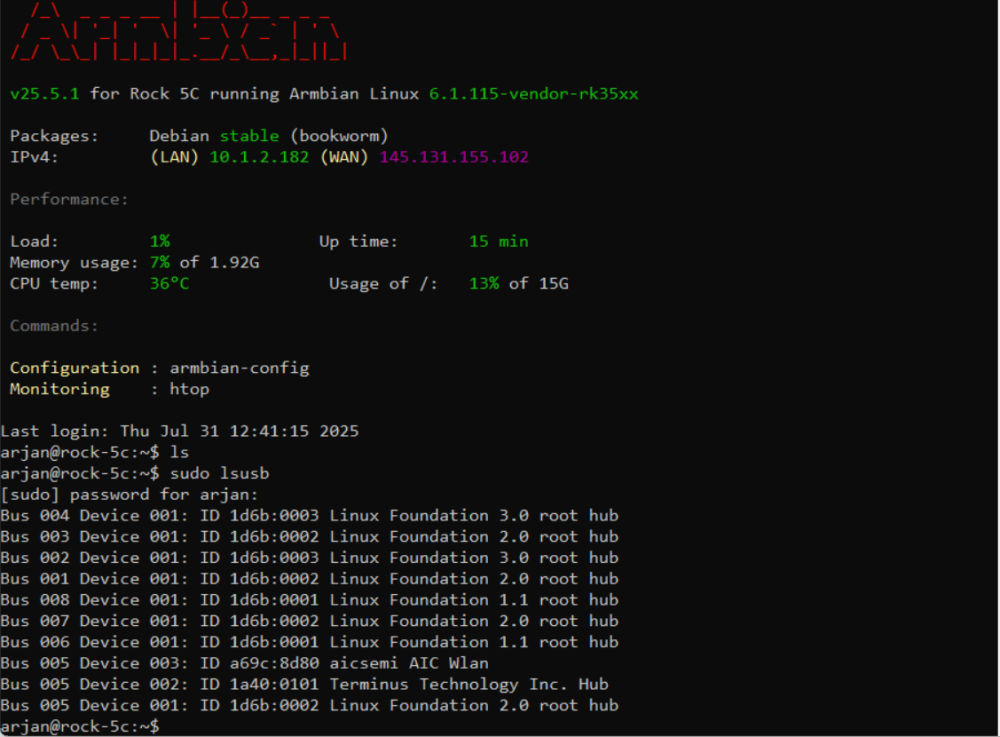Active threads
Showing topics posted in for the last 365 days.
- Past hour
-
I ordered a NVMe HAT and the SSD works fine now. Thank you. Regards
-
R-TV Box S10 I know this is an old topic but I am trying to get this S10 box going for a old colleague which updated and now no longer starts but stays in the animation and not booting into android. Cannot find any firmware download. Thanks in advance
- Today
-
[|] Error 1 occurred in main shell [ at /armbian/.tmp/work-5d76f14c-45ca-4630-ba99-8ded11db4ca4/uboot-write-Fhg7X/usr/lib/u-boot/platform_install.sh:6 and tracking down that platform_install.sh yields dd if="$SRC"/cache/sources/arm-trusted-firmware/mtksoc-20250212/build/mt7988/release/bl2.img of=$2 bs=512 seek=34 status=noxfer > /dev/null 2>&1; Note that cache/sources/arm-trusted-firmware does not appear to exist, and [although this may be my lack of knowing what to look for] I find no evidence it attempted to fetch this repo or build the firmware. Yes, this board is only recently submitted, so some problems may be expected. I did wait for the automated build, but no luck there. or maybe I'm screwing up the build somehow. Using docker, but it's on a Debian11 host, which I know isn't supported as a build platform. ./compile.sh build BOARD=bananapir4 BUILD_MINIMAL=yes RELEASE=bookworm DEBUG=yes KERNEL_CONFIGURE=no BRANCH=current Full build log here: https://paste.armbian.com/isidematup @chainsx looks to be the guy who submitted the pull-request.
-

Rock 5C (Lite) - Wifi is not working or driver not found
ajvuik replied to PHYO ZIN KHANT's topic in Radxa Rock 5C
-
resolution: https://github.com/armbian/build/issues/8400#issuecomment-3136454158
-
I got hardware acceleration working in wayland+labwc, in Bookworm, Linux 6.15.4, self built armbian With a self-compiled labwc (instructions: https://forum.armbian.com/topic/53797-labwc-wayland-crashes-on-exit/#findComment-223267 ) And the ffmpeg instructions in the original post were used with no changes... plus the extraargs=cma=256M in armbianEnv.txt Side question: can anybody make hardware acceleration work in Trixie?
-

labwc (wayland) crashes on exit
robertoj replied to robertoj's topic in Software, Applications, Userspace
Yes. Correct. Start with an armbian minimal or xcfe image that you build, with linux edge. Then install all the compilation dependencies mentioned in https://github.com/labwc/labwc/wiki and https://github.com/swaywm/sway/wiki/Debian-10-(Buster)-Installation#install-wlroots Some are mentioned as indicated for raspberry, but I installed them as well Do not install the debian bookworm libwlroots10 !! (this old wlroots interferes with the wlroots that will be installed now) Do not install libelogind-dev (it tried to modify my initramfs, it messed up the boot process, I didnt actually need it) You need a meson compiler more recent than bookworm provides. Install the backports repo: https://backports.debian.org/Instructions/ $ sudo apt install meson/bookworm-backports $ meson -v 1.7.0 Getting the labwc source code, and building: $ sudo apt install foot seatd (a minimal xterm for wayland, and a "seat manager" (may not be needed)) $ git clone https://github.com/labwc/labwc $ cd labwc $ meson setup build <-check that you have at least the GLES2 or EGL renderer If not, check that you have these dependencies: libegl-dev, libegl1-mesa-dev, libgles2-mesa-dev, libgles-dev If xwayland is desired, install xwayland from the bookworm repo After installing extra dependencies, run reconfiguration: $ meson setup --reconfigure build You will notice that the labwc build process auto-downloads and compiles a recent wlroots Finally compile (it took less than 5 minutes in my orange pi zero 3) $ meson compile -C build If it finishes compiling, check that the produced labwc works with: $ ./build/labwc -s foot If there's an error about memory allocation, add to armbianEnv.txt "extraargs=cma=256M", then reboot To install globally: $ sudo meson install -C build Test by exiting the labwc folder: cd ~ $ labwc -s foot Tomorrow, I will continue installing a display manager and greeter that works with wayland... since I am trying to avoid X11, due to my SPI LCD driver But all of you who try getting labwc in bookworm, hopefully the meson install command does something that lets lightdm see it is available as an option (I started with a minimal image) -

Banana Pi M2 Ultra boot freezing trying to scan the EMMC
赵凌 replied to goosnarrggh's topic in Allwinner sunxi
Actually, on my board, this value can be set to either 1 or 4. Setting it to 4 provides a significant boost to read/write performance, while a value of 8 fails the test. -
When auto login is enabled, this is how it starts - its in "show all screens" mode. I don't know how to fix this - its some Gnome settings / it doesn't bother me as click of a mouse to the empty space solves it. I saw you are trying Debian variant. Here it might be better to stick to Ubuntu based - its more polished. Weird beep you are experiencing - I haven't tested this HW for awhile, but so far I didn't notice it. Dunno where that is coming from.
-
Thanks everyone. I went with another phone and distro (ubuntu touch) since i found a fully supported one.
-
As @Werner said and then just ask any specific questions you may have. Welcome to the Armbian community, @Sahil Usmani.
-
Seriously? https://www.lmgt.org/?q=simulate+high+latency https://duckduckgo.com/?q=simulate+high+latency You're welcome. "Many many months" of what?
-
I've started using an MXQ-4K box as a file server, but writing files over the network is slow, with speeds in the 3-5 MB/s range. Reads cap out at the fast ethernet link speed (~11 MB/s). I don't believe there's a CPU, disc, or RAM bottleneck as the speeds are the same regardless of file size or transfer protocol as SMB, FTP, and WebDAV all give me the same speeds, and checking in htop, they are never at 100%. These speeds are also observed when downloading a file from another device on the local network using wget or aria2 while sshed into it, with faster speeds on other devices. As far as I can tell, iostat doesn't suggest high io wait times are the culprit. If it matters, I'm writing to an external USB HDD, but the write speeds are the same when writing to the SD card through the network, which makes me believe this is not an issue. If I write a ~1.0GB file using dd to the HDD while sshed into it with `dd if=/dev/random of=/mnt/disk/tmp.bin bs=64k count=16500 conv=fdatasync`, it gives a local disk speed of ~20 MB/s, which is more than enough to saturate the 100 mbps link. Has anyone else experienced similar results? Are the slow network speeds just a limitation of the onboard nic/hardware? I'm open to suggestions.
-
You are asking for help. Have you actually followed the guidance you were given, though? Have you been successful to compile an image for any target (virtual or otherwise)?
-
@Sandeep Please don't hijack / necro old threads. You have a completely different issue from the OP, this particular one was already solved. Please open a new thread and show the output of "cat /etc/apt/sources.list /etc/apt/sources.list.d/*.{list,sources}". Feel free to ping me there and I'll be happy to help.
- Yesterday
-
Thanks a lot, It works! I've bought the orange pi zero 2 rencently, with also the board version v1.5, but in my case it seems that "pull PC5 to GND" is still needed, which is written at wiki: I use the latest Armbian IoT based on Ubnutu: So it may have some variant? Whatever, as it says: "pull PC5 to GND", I used a 2pin jumper(header) to shortcut the pin13(PC5) and pin14 rather than pin13 and pin9, since they are next to each other, and it works! 🙂 So I posted here in case someone runs into the same issue.
-
You can find the dram config options here. https://elixir.bootlin.com/u-boot/v2025.07-rc2/source/arch/arm/mach-sunxi/Kconfig if DRAM_SUN50I_H616 config DRAM_SUNXI_DX_ODT hex "DRAM DX ODT parameter" help DX ODT value from vendor DRAM settings. config DRAM_SUNXI_DX_DRI hex "DRAM DX DRI parameter" help DX DRI value from vendor DRAM settings. config DRAM_SUNXI_CA_DRI hex "DRAM CA DRI parameter" help CA DRI value from vendor DRAM settings. config DRAM_SUNXI_ODT_EN hex "DRAM ODT EN parameter" default 0x1 help ODT EN value from vendor DRAM settings. config DRAM_SUNXI_TPR0 hex "DRAM TPR0 parameter" default 0x0 help TPR0 value from vendor DRAM settings. config DRAM_SUNXI_TPR2 hex "DRAM TPR2 parameter" default 0x0 help TPR2 value from vendor DRAM settings. config DRAM_SUNXI_TPR6 hex "DRAM TPR6 parameter" default 0x3300c080 help TPR6 value from vendor DRAM settings. config DRAM_SUNXI_TPR10 hex "DRAM TPR10 parameter" help TPR10 value from vendor DRAM settings. It tells which features should be configured, like write leveling, read calibration, etc. config DRAM_SUNXI_TPR11 hex "DRAM TPR11 parameter" default 0x0 help TPR11 value from vendor DRAM settings. config DRAM_SUNXI_TPR12 hex "DRAM TPR12 parameter" default 0x0 help TPR12 value from vendor DRAM settings.
-
after last rolling update wifi has gone... but bluetooth is fine... apt list --upgradable armbian-bsp-cli-bananapim4zero-current/noble 25.8.0-trunk.442 arm64 [upgradable from: 25.8.0-trunk.428] armbian-firmware/noble,noble 25.8.0-trunk.442 all [upgradable from: 25.8.0-trunk.428] .... linux-dtb-current-sunxi64/noble 25.8.0-trunk.442 arm64 [upgradable from: 25.8.0-trunk.428] linux-image-current-sunxi64/noble 25.8.0-trunk.442 arm64 [upgradable from: 25.8.0-trunk.428] how to fix this?
-
Hi @Alex T Indeed the board seems to be dead not getting turned on at all. Even tried to boot with the secondary BIOS but not working. I managed to fit the new board in the older case so its perfectly being utilised.
-
Heya, No issue here with a rock 5b plus with rkmppenc v0.15 under kernel 6.1.115 on armbian 25.5.1 using HEVC transcoding: acas@rock-5b-plus:~$ rkmppenc -c hevc --preset best --audio-codec aac --vbr 700 -i ~hts/recordings/foo.ts -o ts.mkv -------------------------------------------------------------------------------- ts.mkv -------------------------------------------------------------------------------- [h264 @ 0xaaab23a61de0] non-existing PPS 0 referenced arm_release_ver: g24p0-00eac0, rk_so_ver: 6 rkmppenc (aarch64) 0.14 (r493) by rigaya, Apr 5 2025 09:08:50 (gcc 13.3.0/Linux) OS: Armbian 25.5.2 noble (6.1.115-vendor-rk35xx) aarch64 CPU: Cortex-A76 aarch64 (4P+4E,8C/8T) Input Info: avmpp: H.264/AVC, 1920x1080, 25/1 fps Output: H.265/HEVC main @ Level auto (main tier) 1920x1080p 1:1 25.000fps (25/1fps) avwriter: hevc, #1:mp2/stereo -> aac/stereo/128kbps, #2:aac_latm/stereo -> aac/stereo/128kbps => matroska Quality: best VBR: 700 kbps Max bitrate: 875 kbps QP: Min: 0, Max: 51 GOP Len: 300 frames CHECKPTS: check_pts(1/1): timestamp of video frame is smaller than previous frame, changing pts: -16 -> 2 (previous pts 0). CHECKPTS: check_pts(2/2): timestamp of video frame is smaller than previous frame, changing pts: -24 -> 4 (previous pts 2). CHECKPTS: check_pts(3/3): timestamp of video frame is smaller than previous frame, changing pts: -8 -> 6 (previous pts 4). ^C.8%] 8506 frames: 496.29 fps, 743 kbps, remain 0:05:37, est out size 624.3MB Encoding aborted. encoded 8917 frames, 489.43 fps, 743.66 kbps, 31.62 MB encode time 0:00:18, CPULoad: 0.0% frame type IDR 30 frame type I 30, avgQP 26.73, total size 1.22 MB frame type P 8887, avgQP 30.84, total size 30.40 MB Finished with error in rkmppenc. From looking at your logs, looks like a Device TRee issue - failed to identify key hardware parameters by the looks of it for some reason - change in boot settings? regards Andrew
-

Ugoos AM9 s905x5 ARMBIAN build
Roman Fedorenko replied to Roman Fedorenko's topic in Amlogic CPU Boxes
-
That should be O.K. too.
-
tl;dr; This "only" difference is huge - modern kernel hw specific code is pretty much written from scratch, feature by feature. Not to mention differences in general areas between kernel 6.1 and 6.12, low level boot loader is also usually different. Further reading: https://docs.armbian.com/User-Guide_FAQ/#why-things-stop-working





